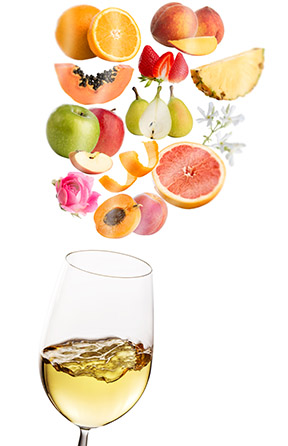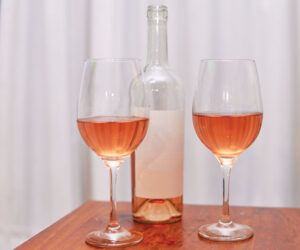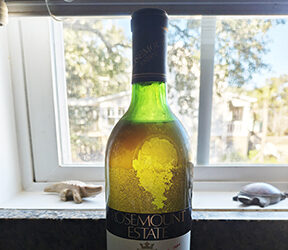Q. I’d like to improve aromatics in my white wines. Last year, I fermented two wines (Riesling and Traminette) at low temperatures (50–55 °F/10–13 °C), used Steinberger yeast to handle the cold temperature and (hopefully) improve phenolics. While the wines did well in judging, the scores for aroma and bouquet were in the “meh” range. Both juices were purchased from a local winery shortly after picking, so were relatively fresh. What else can I do to improve phenolics/aromas? Note: Last year was a rather wet year, so it wasn’t the best year for many wines. Could it have been just a bad year for me to try to make aroma bombs?
Larry Roux
Syracuse, New York

A. It sounds like you’re doing a lot of things right to optimize aromas in what should be “aromatic” white varieties. I would recommend you make sure your full process includes the following (some of which you describe that you’re already doing):
Pick/harvest cool
Pick at night or in the early morning if you can. Cool grapes retain their aromatic compounds better upon pressing than warm grapes do. Warmer grapes also tend to grow spoilage organisms more readily, which can easily lead to “funky” aromas in all stages of the winemaking process from pressing to fermenting to aging. If you want to maintain the purity of your natural grape aromas, avoid inviting too many unwanted microbial friends to the party.
Keep the pH below 3.5
I’ve had the best luck maintaining aromatic freshness when grapes and juices have a pH of about 3.20–3.50. This is somewhat related to the temperature point I make above, because higher pH encourages what could be unwanted spoilage organisms and their unwanted aroma byproducts. Higher pHs can also lead to higher VA (volatile acidity), another wine flaw when in concentrations higher than around
0.5 g/L.
Pitch an aroma-enhancing yeast
Many commercial wine supply houses (Laffort, Scott Labs, AEB, BSG, etc.) sell lots of yeast strains that claim to enhance aromas. Some interesting cultures are actually mixes of Saccharomyces cerevisiae and non-cerevisiae strains. Your choice of Steinberger seems like a good one, but there may be others you want to try. I love VL3 for Sauvignon Blanc and have been known to pitch CY3079 for Riesling and Gewürztraminer.
Ferment in glass or stainless steel
These are clean, inert containers that don’t contribute any of their own character to a fermentation, unlike oak barrels. Even if an oak barrel is “neutral” it can still allow oxygen into the system, which doesn’t help. The nooks and crannies of barrels are also great insulators and won’t cool off as readily as glass or stainless steel, making fermentations more difficult to keep control of.
Ferment cool (50–55 °F/10–13 °C)
A white fermentation much over 60 °F (15 °C) risks losing some brightness. As an example, fresh pear aromas may end up smelling like “cooked pear” as opposed to fresh and bright aromas of pear. It’s hard to describe, but once you’ve smelled enough fermentations over the years like I have, you’ll understand that even a 10 °F (5 °C) difference in fermentation temperature can make a big difference. Another way to think about it is like a rapidly boiling pot rather than a low simmer. A rapid boil (higher temperature) means that you’re volatilizing off many more aromatic compounds into the air rather than keeping them in your fermentation where they belong.
Try enzymes
Most winemaking supply companies sell enzymes that can be added to must in the press, in the pre-settling juice phase, or in settled and racked juices. Some, like Betaglycosidase enzymes, can even (and in fact must) be used after fermentation because they’re inhibited by high sugar levels. These specialty enzymes can cleave terpenes and norisoprenoids off into the finished wine and release them into the “free” state so they’ll be available as aromatics in the wines. Enzymes can be sold in liquid or powdered form and are extremely useful in breaking down skins so that the maximum amount of aromatic compounds are released into the juice. Pectinases are great added to the crushed fruit or directly in the press as a skin-contact enzyme. They break down skins and pectin, allowing more aromatic compounds to be extracted during pressing. Beta-glycosidase enzymes act upon bound aroma compounds, converting them into the “free” form. Whichever enzyme you choose, it’s always good to follow instructions and to use recommended amounts. Where possible, do bench trials first to see if you like the results!
Q. I fermented 13 gallons (50 liters) of Isabella, a vitus labrusca, wine two years ago and left it to condition on the lees in two carboys. I bottled the wine yesterday. It tastes great, but now the inside of my carboys have a difficult-to-remove red layer on the glass inside. Difficult because I can’t get a brush into the shoulders of the carboys. Is there a chemical that can dissolve this layer?
Paul Tolsma
Port Elizabeth, South Africa
A. There is indeed a combination of things I think could help, but it may take a little bit of elbow grease on your part. Two years is a long time for a red wine to live in a carboy and I’m not surprised that you’ve had some deposits on the inside of the glass. Those deposits likely consist of an agglomeration of tartrate crystals, condensed tannin structures, and possibly some tiny lees particles and other gunk. Understandably, you don’t want all of it to be on your carboy the next time you make a batch!
The first thing I would do would be to soak those carboys in warm water and then add a couple of handfuls of something to be used as an agitator like BBs, buckshot, marbles, or even fine gravel. Let it sit until the water has cooled down to just “warm.” Now here comes the elbow grease part: Dump out enough of the water so you can pick up the carboy and give it big sloshes back and forth. The goal is to use the agitator to loosen up some of that crud on the sides of your carboy. Keep rinsing out the water (keeping the agitator inside) until you can’t get any more of the deposit out using this method. This is essentially your “cleaning” step. Then I would soak the carboy in a warm-to-hot solution of sodium percarbonate (sometimes sold as “ProxyCarb” in home winemaking stores) overnight. I would use about a half cup for a 5-gallon (19-L) carboy. The next day (wearing gloves and safety goggles), I’d pour out some of that solution, toss in my agitator again, and give it some more sloshes back and forth to loosen more sediment. The idea is that the chemicals will have time to work on the remaining crust overnight and the next day you’ll be able to manually loosen some more.
After applying this high-pH solution to dissolve some of the matter, if you’ve got more work to do, I’d follow this with a citric acid rinse (about 2 Tbsp. in a 5-gallon/19-L carboy) and soak it overnight in a solution of about 5 Tbsp. citric acid to a 5-gallon (19-L) carboy of water. Sometimes this will help dissolve other particles that might have been resistant to the higher-pH solution. Do a final rinse with water once you feel you can’t do any more. If there is a little bit of sediment left sticking to the sides of your carboy I wouldn’t sweat it too much. These carboys should be fine for fermentation and even for long-term wine storage if you clean and then sanitize them well ahead of time with something like a quaternary ammonia compound (sometimes referred to as “quats”) solutions, which can be purchased from most home winemaking and brewing supply companies.
Just as an aside, have you tried one of those angled-neck carboy brushes? Most home winemaking supply stores sell various types that are specially designed to reach into those awkward angles and corners. I’m guessing you’ve not been able to find one that is a good match for your carboy . . . and at any rate, sometimes carboy brushes just can’t exert enough pressure on stubborn deposits. Though, if you can find one, in addition to the solutions mentioned earlier, they can be quite helpful.
Q. We have several of our winemaking club members dealing with mycoderma (a white surface film yeast) on their wines in carboys and barrels. We are wondering if using high-proof alcohol (190-proof) as a spray on top of the wine would kill the growth and then it could be filtered out?
Dan Boykin
Camino, California
A. There is a great summary of what mycoderma is and ways to deal with it written by Daniel Pambianchi at www.techniquesinhomewinemaking.com/white-surface-film. Folks can check out that blog post for a deep dive, but to skim the surface (pun intended), mycoderma, or surface film yeast, is largely caused by oxygen ingress during wine aging and can be found in a thin skin-like growth in the necks of carboys and in slightly un-topped barrels. In Daniel’s post, he gives all sorts of very descriptive (and handy!) tips for cleaning your wine of this surface nuisance or racking your wine away from it. All of that effort will be for naught, however, if the wine isn’t stored in an air-tight way after the fact.
Your suggestion to spray the surface with-high proof alcohol followed by a filtration is a decent one. Even 190-proof alcohol, however, is unlikely to “kill” a surface bloom like that because 1) the film yeast are perfectly happy living in an alcoholic (albeit lower-proof) environment and 2) once the high-proof ethanol hit any wine it would become diluted and/or evaporate, therefore lowering the toxicity of the high-proof spray. If you have some on hand, however, it won’t hurt to try some sprays; it will at least slow down and inhibit the film yeast colonies somewhat and slow its spread.
Sterile filtration, on the other hand, will always exclude spoilage yeast, which are actually much bigger cells than bacteria. If you’re able to filter to a 0.45-micron nominal pore size, you’ll filter out both spoilage yeast and bacteria, leaving you with clean wine. The end result is the same, however. If you don’t have a topped-up and airtight way to store your wine afterwards, even sterile filtered wine can develop film yeast given enough time and the insidious ingress of oxygen.
Q. I am hoping you can resolve a discussion between fellow winemakers regarding sanitizing solutions. A simple, no-rinse solution is 1 tablespoon citric acid and 2 teaspoons KMBS (potassium metabisulfite) per gallon (3.8 L) of water. I use this all the time, and generally use de-ionized water. Understanding that an acid helps the sulfite to be more effective, could you explain: 1) Why this is the case, and 2) why tartaric may (or may not) be a better choice than citric given its already natural abundance in wine and less risk of citric acid metabolism complications during malolactic fermentation?
Steve Meharg, PhD.
Longview, Washington
A. I’m happy to help clear up the argument for you. First, I have to say, “good on you” (as my New Zealand harvest interns used to say) for questioning what you hear; discussing vinous conundrums is how we learn! It’s so engaging to have these discussions with our winemaking peers, opening our minds to different views and ways of thinking; it happens in professional circles all the time!
To answer the first question: Indeed, you are correct. Adding acid to a KMBS solution makes it more effective as a sanitizing agent. This is because the lower the pH, the higher the percentage of the two “biologically active” forms of sulfur dioxide — molecular SO2 and bisulfite (HSO3–) — you’ll have in your aqueous solution. These are the two forms that directly disrupt biological activity (which is what we’re trying to stop with sanitation in the first place) of spoilage yeast and bacteria. The higher the pH (meaning the lower the acidity), the higher concentration of KMBS powder you’d need to do the same job. Basically, the acid you’re adding forces more of the sulfur dioxide to exist in a more potent form.
To answer your second question, my response is very simple: Cost. Tartaric acid is many times more expensive than citric acid, which is why, since it’ll just end up getting sprayed around the cellar and eventually going down the drain, most wineries of any size don’t use tartaric acid in sanitizing solutions and sprays. However, as you know, home winemakers aren’t often as constrained by cost as large commercial establishments, so if you’ve got a bag of tartaric sitting around and you’d like to use it, go right ahead. Citric acid metabolism during malolactic fermentation is an uncommon (but significant) risk (causes carbon dioxide and some metabolic byproducts), but most wineries don’t worry too much about it. I’d wager that the amount of citric left sitting undissociated on dry equipment surfaces post-sanitation is small.







